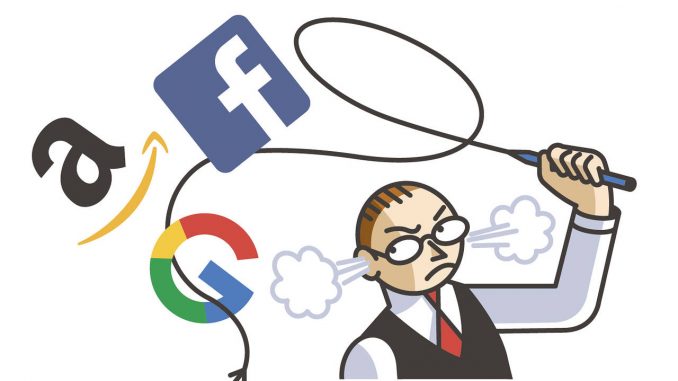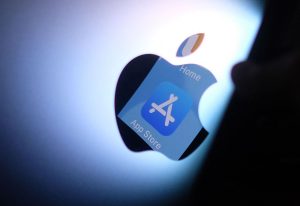
What is the “techlash”?

Figure 1. “Where does tech regulation go in 2020?” by Alain Jocard is licensed under CC BY-SA 3.0
The rapid growth of technology enabled social media to gradually occupied people’s life, advances in technology has brought public concerns about social media. Public concerns toward new technologies and big tech companies have been identified as a word “techlash”. Atkinson et al., (2019) define the “techlash” as two aspects. One is people growing animus toward “Big tech” companies. But this concept is broader, more essential idea of “techlash” opposition to technological innovation itself.
This emerging phenomenon has attracted global attention. Big media companies and local governments have responded to the techlash phenomenon with their policies but have yet to find the right balance. Under this context, this essay will discuss the public concerns behind the “techlash” from Flew (2018), misinformation and privacy, hate speech and industry monopoly, and how big tech companies and government-controlled over the “techlash” issue.
Public concerns behind the techlash
- Misinformation and privacy concerns
The research from the press book, Turning point: Policymaking in the Era of Artificial Intelligence, West (2019) found that people are concerned about fake news and privacy. Many individuals suppose technology has developed too rapidly, and it is hard to distinguish fake news within an issue. In the United States, a study shows that the trust toward technology has fallen from 78% in 2012 to 57% in 2021. The freedom of the internet provides the rapid spread of “fake news” (King, 2019). Data security also arise along with misinformation. Google’s search engine can pinpoint its target audience. Although this is the embodiment of full intelligence, the individual’s privacy information security concerns have never decreased. That is why some big tech companies face the hard wish from the public to safeguard their data security (King, 2019).
The public concerns behind techlash from AXIOS: Source: Youtube – https://www.youtube.com/watch?v=i97NCUMhLU4&t=20s
- Concerned about the hate speech and abusive language

Figure 2. “Hate Speech and Social Media: Preventing Atrocities and Protecting Human Rights Online” by Getty Images is licensed under CC BY-SA 3.0
People are gradually against online social media because tech negatively affects mental health (King, 2019). Under the social media principle of freedom of speech, some internet users spread malicious and incite radical discourse on the internet wantonly. People using freedom of speech as the main excuse to express individual distorted emotions and thoughts. This phenomenon origin from the big tech companies’ lax management within their platform. Giant tech companies provide platforms for hate speech and insult to ferment and spread online. In addition, people’s dependence on social media makes it difficult for them to give up their life away from social media. Therefore, this phenomenon becomes a vicious internet cycle, which is why individuals feel disturbance about the hate speech and abusive language online.
With the growth of the internet, the era has turned from an open online media environment to a social media industries monopoly (Flew et al., 2019). The gradual growth of the giant tech companies has made it possible for a small number of big tech companies to dominate the entire tech market. Other small companies cannot survive in today’s social media platform. Picard (2017) points out that dominance power is demonstrated in markets through the control of production and prices by dominant players, thereby harming consumers through higher prices, reduced choice, and poor service. In the meantime, big tech companies prevent other companies from entering and controlling the market and thus prevent other competitors from entering the market. Monopolistic markets tend to hurt the most ordinary users, while monopolistic markets benefit a small number of wealthy corporations and billionaires (Chatterton, 2020).
Apple uses its operating system and app store to create barriers to its competitors and maintain monopoly power toward distributing software apps on iOS devices. The report found that “apple company has become more insistent that developers use in-app purchases as the company’s services business, which includes the App Store, becomes a driver of growth and profits.” (Leswing, 2020). Consequently, developers are either passing on price increases to consumers or investing less in innovative new services. This monopoly policy makes consumers unable to enjoy the service experience and unable to get rid of the control of Apple due to the dependence on the iOS system.

Figure 3. “Apple dodges ‘monopoly’ label…for now” via AEP, is licensed by CC BY-SA 3.0
Policy about preventing the “techlash”
There is a claim from Picard (2017) that some existing policies are unable to catch the fast growth of technological, economic, political and social development because they do not have a rational policy principle. With the same idea of Picard, Palmer (2018, cited in Hemphill, 2019, p. 241) also point out that the premise of solving techlash is to find the principle of responsible innovation and continue to innovate without harming users and competitors. Therefore, he proposes three basic approaches to achieve accountable technological innovation. Government regulation is the first one in this approach, aimed for government to make policies to regulate the platform content. Self-regulation asks individual companies to hold social responsibility to do internal control within their platform. The last one is a self-regulatory organization. Under the principles of responsible innovation, SRO members oversee and regulate compliance with those principles and report any violations to a federal regulatory agency.
Based on the report from John (2020), it has been found that the American people are ambivalent about whether the US government will solve the problems of technology companies. Although they hope that the government will formulate policies to prevent techlash out of managerial belief and the responsibility to protect citizens, politicians lack professional and efficient measures and knowledge about the management of technology companies. For the method of government supervision, the most efficient way is to formulate corresponding laws.
However, Palmer (2018, cited in Hemphill, 2019, p. 241), the propagator of this method, are critical of the government control policy. Palmer supposed the move of technology makes the speed of policy issuance unable to catch up with the speed of new technology problems appeared. In addition, another consideration from Scott (2019) about government regulation is that big tech companies will likely shrug off government control and policies. Under the monopoly conditions of the technology market, the big technology companies have been contemptuous in the face of censorship and legal punishment. Because they already have a stable market, it is difficult for users to switch from big tech companies to small unknown ones. Therefore, the government’s control is a less powerful control mechanism in a certain way.
Although government policy does not suit regulating large monopolistic technology firms, internal governance is essential to maintaining a reputation for big tech companies. Some scholars tend to let the big tech companies make regulations within their platforms. According to Flew (2016, cited in Flew et al., 2019, p. 35), under the relationship between social media platform and publishing becoming blurred, the responsibility of controlling content and regulation come to social media platform. The big social media companies commit to operating the self-regulation strategies because they can directly control the content within the forum. Social media firms are increasingly monitoring, regulating and deleting content or blocking and restricting some users.

Figure 4. “Facebook bans Trump for two years, as social media giant changes controversial moderation rules” by Salon is licensed under CC BY-SA 3.0
Facebook has also overhauled its platform in the wake of revelations about election fraud and other fake news. Many substandard posts were labelled as untrue, and some of the offending videos were selectively removed. Facebook also took a step further by banning Trump from using its platform in the wake of the January 6 us government rebellion. It is a regulatory breakthrough unprecedented in the history of social media. Palmer’s view fits into this phenomenon, based on the way Facebook has developed its regulatory policies. Big tech companies’ self-regulation is a passive process. Policies always appear when the issues occur in the big tech companies’ platform, which is weak for protecting users because they already experienced low-quality service before point operate.
Looking at the way forward
Techlash is a conundrum for big modern tech companies, and it affects users’ attitudes to the technologies development. As policy measures were imposed, there were gaps in both government supervision and platform self-management. Finding the right balance between technology and user protection is now the goal. People should see the nature of the development of science and technology, which is a tool rather than a considerable challenge. The moderate use of technology is the best way for users to enjoy technology innovation.
References
BALTIC APPRENTICESHIPS. (2019). What is Techlash and what does it mean for. the digital industry? Retrieved from: https://www.balticapprenticeships.com/blog/what-is-techlash-and-what-does-it-mean-for-the-digital-industry
Brookings. (2021). Techlash continues to batter technology sector. Retrieved from: https://www.brookings.edu/blog/techtank/2021/04/02/techlash-continues-to-batter-technology-sector/
CNBC. (2020). Apple’s ’monopoly power’ over iPhone app distribution gives it. outsized profits, antitrust committee says. Retrieved from: https://www.cnbc.com/2020/10/06/house-antitrust-subcommittee-apple-has-monopoly-power.html
Flew, T., Martin, F., & Suzor, N. (2019). Internet regulation as media policy: Rethinking the question of digital communication platform governance. Journal of Digital Media & Policy, 10(1), 33-50. https://doi-org.ezproxy.library.sydeny.edu.au/10.1386/jdmp.10.1.33_1
Flew, T. (2018). Platforms on Trial, Intermedia, 46(1), pp. 16-21.
ITIF. (2019). A Policymaker’s Guide to the “Techlash”—What It Is and Why It’s a. Threat to Growth and Progress. https://itif.org/publications/2019/10/28/policymakers-guide-techlash
John, S., & James, L. (2020). Techlash? America’s Growing Concern With Major Technology Companies. https://knightfoundation.org/reports/techlash-americas-growing-concern-with-major-technology-companies/
Picard, R., & Pickard, V. (2017, April). Essential Principles for Contemporary Media. and Communication Policymaking. https://reutersinstitute.politics.ox.ac.uk/sites/default/files/research/files/Essential%2520Principles%2520for%2520Contemporary%2520Media%2520and%2520Communications%2520Policymaking.pdf
Scott, M. (2019). In 2020, global ‘techlash’ will move from words to action. https://www.politico.eu/article/tech-policy-competition-privacy-facebook-europe-techlash/
Thomas A. Hemphill. (2019). ‘Techlash’, responsible innovation, and the self-regulatory organization, 6(2), 240-247. http://doi.org/10.1080/23299460.2019.1602817

The public concerns and policy implementation behind the techlash is licensed under the CC BY-NC 4.0